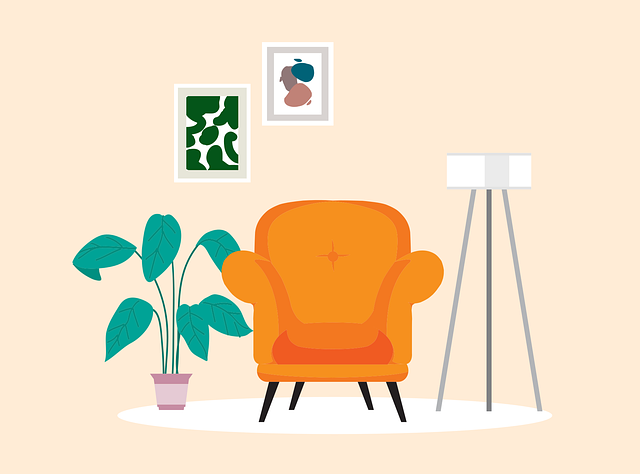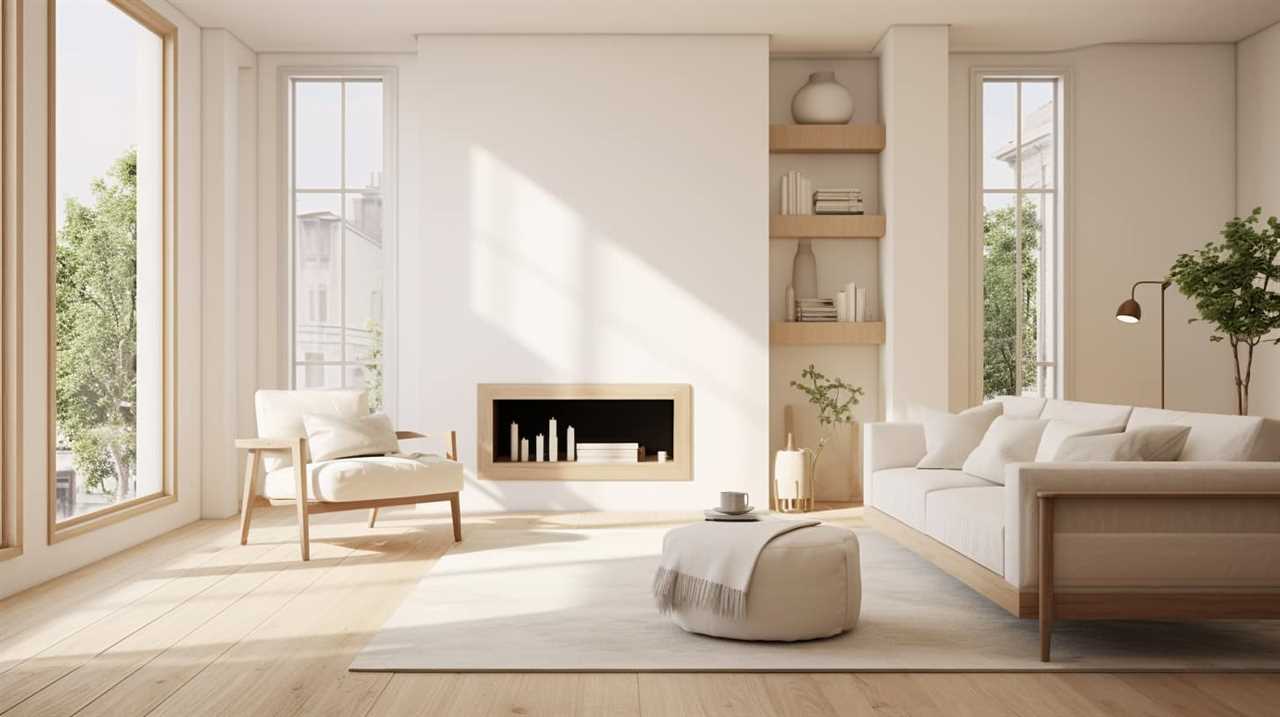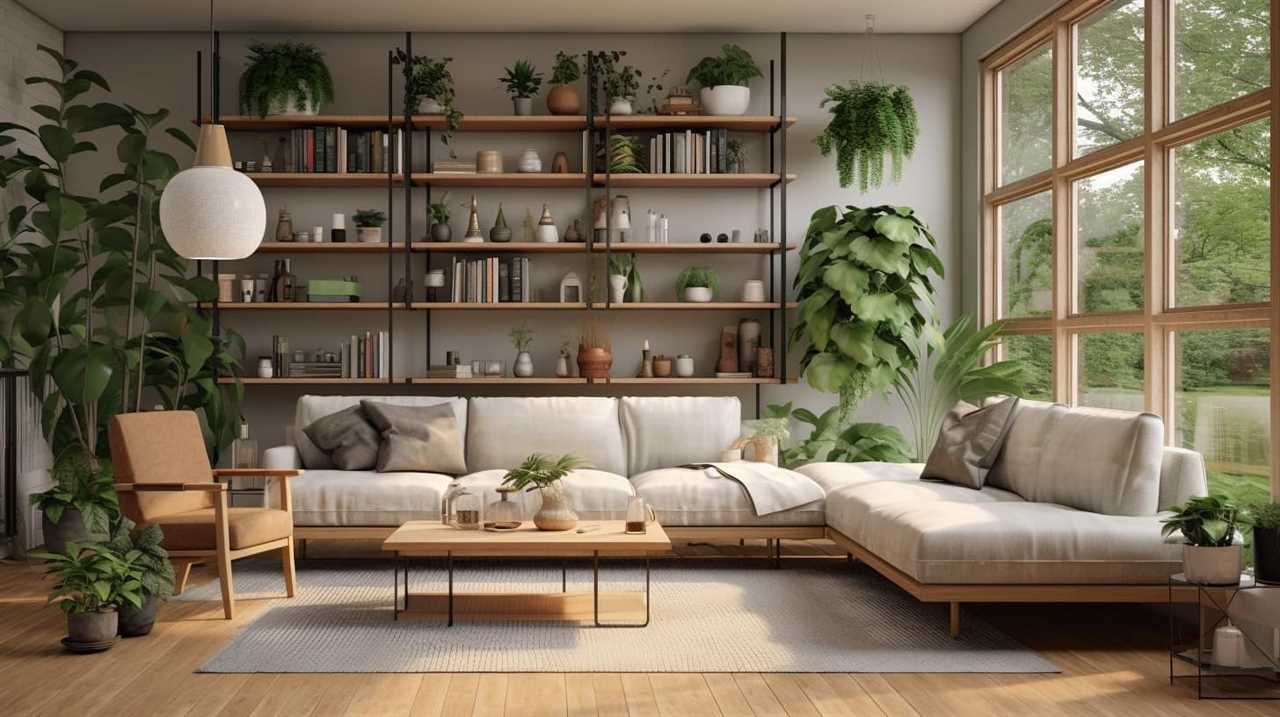At first, we may be hesitant to embrace minimalism. But let us tell you, the benefits are worth it.
By decluttering our lives, we open ourselves up to a world of mindfulness, stress reduction, and enhanced mental health. With increased clarity and focus, improved decision making, and heightened productivity, we find ourselves more efficient and effective.
Not to mention the greater financial freedom, heightened creativity, strengthened relationships, and promotion of environmental sustainability. Embracing minimalism truly serves us and others.
Key Takeaways
- Cultivating mindfulness and present moment awareness can help reduce stress and overwhelm.
- Embracing minimalism can enhance mental health and well-being, creating a sense of calmness and tranquility.
- Prioritizing quality over quantity fosters a positive mindset and emotional balance.
- Adopting an eco-friendly lifestyle and supporting sustainable practices promotes environmental sustainability.
Increased Clarity and Focus
We find that embracing minimalism helps us gain increased clarity and focus in our daily lives. By simplifying our surroundings and reducing clutter, we create a space that promotes improved concentration and better time management. When we remove unnecessary distractions, we’re able to direct our attention and energy towards what truly matters.

Minimalism allows us to prioritize our tasks and responsibilities, enabling us to allocate our time more efficiently. With a clear and focused mind, we’re better equipped to tackle challenges and make informed decisions.
The practice of minimalism also helps us cultivate mindfulness and presence in our daily activities, allowing us to fully engage and appreciate each moment. By embracing minimalism, we’re able to enhance our overall productivity, leading to a more balanced and fulfilling life.
Improved Decision Making
When it comes to improved decision making, embracing minimalism offers us a clearer path. By eliminating the clutter and distractions in our lives, we gain clarity in our choices.
With fewer options to consider, we’re less overwhelmed and can focus more on what truly matters. This increased focus leads to higher productivity levels, as we can make decisions efficiently and confidently.

Clarity in Choices
By prioritizing quality over quantity, we gain clarity in our choices, allowing us to make better decisions for our well-being. Simplified decision making and reduced decision fatigue are two essential benefits of embracing minimalism.
When we simplify our lives and declutter our physical and mental spaces, we’re able to focus on what truly matters, leading to a clearer understanding of our priorities and values. This clarity enables us to make decisions more efficiently and effectively.
With fewer distractions and less clutter, we’re better able to evaluate our options and choose what aligns with our goals and values. By embracing minimalism, we free ourselves from the burden of excessive choices, leading to improved decision making and a greater sense of fulfillment in our lives.
- Simplified decision making
- Reduced decision fatigue
- Greater sense of fulfillment
Less Overwhelm, More Focus
Our reduced overwhelm and increased focus lead to improved decision making when we embrace minimalism. By adopting a minimalist lifestyle, we can free ourselves from the constant bombardment of choices and distractions that often leave us feeling overwhelmed and scattered. Instead, we can cultivate mindful living and make intentional choices that align with our values and priorities.

When we reduce the clutter in our physical space, we also declutter our minds. This allows us to focus our attention on what truly matters, enabling us to make more informed and thoughtful decisions. With fewer options vying for our attention, we can devote our energy to the choices that have the greatest impact on our lives.
To illustrate the benefits of minimalism in decision making, consider the following table:
| Overwhelm | Focus | Decision Making |
|---|---|---|
| Reduced | Increased | Improved |
As you can see, embracing minimalism leads to less overwhelm, more focus, and ultimately, improved decision making. So why not simplify your life and experience the benefits of making intentional choices?
Increased Productivity Levels
As we embrace minimalism, we can experience increased productivity levels and improved decision making. Simplifying our lives allows us to focus on what truly matters, leading to better time management and work-life balance. Here are three ways minimalism enhances our productivity:

-
Eliminating distractions: By decluttering our physical and digital spaces, we create an environment conducive to concentration and focus. This enables us to make quicker and more informed decisions, without the constant noise and visual clutter.
-
Streamlining priorities: Minimalism helps us identify our core values and priorities. By letting go of unnecessary commitments and possessions, we free up mental space and energy to focus on what truly matters. This clarity allows us to make better decisions and allocate our time and resources more effectively.
-
Reducing decision fatigue: Minimalism involves simplifying our choices. By eliminating unnecessary options and reducing decision fatigue, we can make decisions more efficiently and confidently.
Enhanced Productivity and Efficiency
We can experience a noticeable increase in productivity and efficiency by embracing minimalism. By simplifying our lives and decluttering our physical and digital spaces, we create an environment that promotes improved time management and a streamlined workflow.

Minimalism allows us to focus on the essential tasks and eliminate distractions that can hinder our productivity. When we have a clear and organized workspace, it becomes easier to prioritize our tasks and stay on track.
With fewer possessions and commitments, we have more time and energy to devote to our work. This increased productivity not only benefits us but also allows us to serve others more effectively. Embracing minimalism empowers us to achieve more with less, making us more efficient and productive in our daily lives.
Greater Financial Freedom
By adopting minimalism, we can achieve greater financial freedom through mindful spending and intentional saving. Simplified budgeting is a key aspect of minimalism that allows us to have a clear understanding of our income and expenses. With a simplified budget, we can prioritize our spending on what truly matters and cut out unnecessary expenses.
Reduced consumerism is another advantage of embracing minimalism. By focusing on our needs rather than our wants, we can avoid unnecessary purchases and save more money. This shift in mindset helps us break free from the cycle of constant consumption and find contentment in what we already have.

Ultimately, minimalism empowers us to take control of our finances and achieve greater financial freedom.
Heightened Creativity and Inspiration
Our minds become more open to new ideas and our creative potential is unleashed when we embrace minimalism. By simplifying our lives and reducing the clutter, we create space for artistic expression and innovative thinking.
Minimalism encourages us to focus on what truly matters, allowing us to tap into our imagination and explore new possibilities. When we let go of material possessions and unnecessary distractions, we free up mental energy that can be channeled towards creativity.
This newfound clarity and inspiration can lead to breakthroughs in various areas of our lives, whether it’s in art, writing, problem-solving, or even entrepreneurship. Embracing minimalism opens up a world of fresh perspectives and encourages us to think outside the box, fostering a sense of curiosity and wonder.

As we explore the benefits of minimalism, we also strengthen our relationships and connection with others, creating a more fulfilling and meaningful life.
Strengthened Relationships and Connection
Embracing minimalism helps us cultivate deeper connections and strengthen our relationships through intentional and meaningful interactions. By simplifying our lives and focusing on what truly matters, we create more space for genuine communication and connection with others. Here are three ways in which minimalism can strengthen our relationships:
-
Strengthened Communication: When we declutter our physical space and reduce distractions, we can engage in more focused and present conversations. Minimalism encourages us to actively listen and communicate our thoughts and feelings more effectively, leading to stronger and more fulfilling relationships.
-
Improved Empathy: Minimalism encourages us to prioritize experiences and relationships over material possessions. By shifting our focus towards understanding and supporting others, we develop a deeper sense of empathy. This allows us to connect with others on a more profound level and build stronger bonds.

-
Enhanced Quality Time: Minimalism promotes intentional living, allowing us to make deliberate choices about how we spend our time. By eliminating unnecessary commitments and distractions, we can prioritize quality time with loved ones, fostering deeper connections and creating lasting memories.
Embracing minimalism not only strengthens our relationships and connections but also promotes environmental sustainability.
Promoted Environmental Sustainability
How can minimalism contribute to and promote environmental sustainability? By adopting an eco-friendly lifestyle and embracing sustainable living practices, minimalism can have a positive impact on the environment. By reducing our consumption and focusing on the essentials, we can minimize waste and decrease our carbon footprint.
Minimalism encourages us to prioritize quality over quantity, leading to a reduction in the production and disposal of unnecessary goods. This shift in mindset promotes the use of renewable resources and supports sustainable practices.

To illustrate the benefits of minimalism for the environment, consider the following table:
| Benefits of Minimalism for Environmental Sustainability |
|---|
| Reduces waste and landfill pollution |
| Conserves natural resources and promotes sustainability |
| Lowers energy consumption and carbon emissions |
Frequently Asked Questions
How Can Minimalism Improve My Mental Health and Reduce Stress?
Embracing minimalism allows us to focus on what truly matters, reducing stress and improving our mental health. By practicing mindful living and reducing clutter, we create a peaceful and organized environment that promotes well-being.
Can Embracing Minimalism Help Me Become More Productive and Efficient in My Daily Life?
Embracing minimalism can increase focus and improve time management, making us more productive and efficient in our daily lives. It allows us to prioritize what truly matters, eliminating distractions and creating space for meaningful work.
What Are Some Practical Ways That Minimalism Can Enhance My Decision-Making Abilities?
Embracing minimalism can greatly enhance our decision-making abilities. With improved focus and increased clarity, we can make more deliberate choices that align with our values and priorities, leading to a more fulfilling and purposeful life.

How Does Living a Minimalist Lifestyle Promote Financial Freedom and Independence?
Living a minimalist lifestyle promotes financial freedom and independence by encouraging mindful spending and prioritizing financial stability. It helps us make intentional choices about our expenses, leading to reduced financial stress and the ability to live within our means.
Can Minimalism Lead to a More Sustainable and Environmentally Friendly Way of Living?
Embracing minimalism can lead to a more sustainable and environmentally friendly way of living. It encourages reducing waste and making conscious choices that benefit the planet. Minimalism helps us align our values with our actions.
Conclusion
In embracing minimalism, we open ourselves up to a world of clarity, focus, and freedom. Our minds become unburdened, allowing us to make better decisions and be more productive. We find ourselves inspired, our creativity flowing effortlessly.
Our relationships deepen, and we connect more authentically with others. And in this journey, we also contribute to a sustainable environment, leaving a positive impact for future generations.

Embrace minimalism and unlock the power of simplicity.
I’m Theodore, and I love tiny houses. In fact, I’m the author of Tiny House 43, a book about tiny houses that are also tree houses. I think they’re magical places where imaginations can run wild and adventures are just waiting to happen.
While tree houses are often associated with childhood, they can be the perfect adult retreat. They offer a cozy space to relax and unwind, surrounded by nature. And since they’re typically built on stilts or raised platforms, they offer stunning views that traditional homes simply can’t match.
If you’re looking for a unique and romantic getaway, a tree house tiny house might just be the perfect option.










